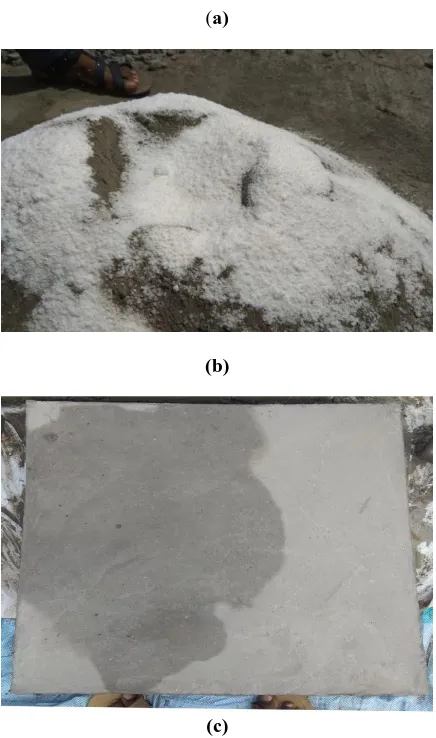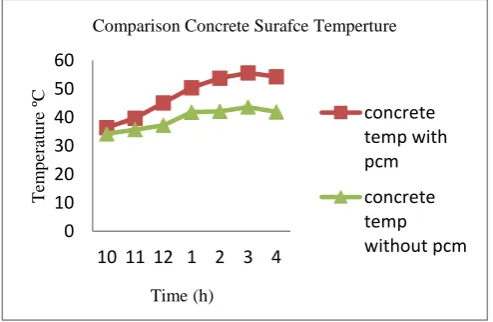IJIRMPS1806011
Website :
www.ijirmps.org
Email : editor@ijirmps.org
71
Experimental Study of Thermal Performance in
Building Concrete Roof with Phase Change Material
M.T. Jaffarsathiqali1 ,R.Satheesh Kumar2, T.Bharathan3, D.Pio Casmir4
1,2,3,4Assistant Professor,
Department of Mechanical Engineering, Dhanalakshmi Srinivasan Institute of Technology, Trichy
Abstract: Phase change materials (PCMs) offer great potential as a latent heat energy storage technique to provide energy
efficient systems in new and existing residential buildings. There are large numbers of PCMs that melt and solidify at a wide range of temperatures, making them attractive in a number of applicationsLow thermal conductivity of the walls and roof reduces the heat gain at a steady state condition. . Lauric acid (C12H24O2) as a phase change material (PCM) for a room was proposed in this paper to control the indoor air temperature for a better thermal comfort for human beings. Building concrete roof 0.7 × 0.7 m mixed with C12H24O2 (PCM) considered for analysis. A detailed thermal performance was carried by experimental study. The Results showed that this type of PCM room can decrease the indoor air temperature fluctuation by a maximum of 5◦C.
Keywords: Latent heat storage, Phase Change Material, Building energy conservation.
I. INTRODUCTION
There are many types of storage system using phase change materials is an effective way of storing energy and also to make advantage of heating and cooling systems are installed to keep temperatures within the well-being zone .PCMs have been extensively used in various storage systems.They are large number of PCMs which meld solidifies at a wide range of temperatures making them beautiful in a number of applications. Thermal energy storage technology with PCMs with many applications those technologies are very beneficial for the humans as well as the energy conversation.Nasser Mostafavinia, SamanEghvay [2015]this paper describe using the PCM as salt instead of paraffin wax to increase the solidification of storage system and It has high thermal conductivity and low cost compared to the paraffin wax.Mohamed M Abdulgalil et al [2014] was presented Effect of thermal energy storage in energy consumption required for air conditioning system in office building under the africanmediterranean climate the results shows that the new layer of ice formed on the surface of the existing ice lead to an increase of thermal resistance of heat transfer, which in return decreased cooling capacity.
A.Manivanan and M.T.Jaffarsathiqali [2015] Investigated the Simulation and experimental study of thermal performance of a building roof with a phase change material (PCM) the results shows that this type of PCM room can decrease the indoor air temperature fluctuation by a maximum of 4◦C.L.Venkatesh et al [2014] was presented the Phase Change Materials In Building Construction toReduce Room Temperature Fluctuations. Medrano M et al [2009] The review on thermal energy storage system using phase changing material and it’s widely used for many applications space heating and cooling in buildings solar application of peak energy storage on heat exchanger in improvement. It concentrates to raise in electric energy cost thermal storagetechnologies. In order to increase the content on the pcm .its prepared by using the macro packed pcm .its prepared by using n-octedecane,n-eicosane and n-docosaneto get the thermal conductivity was more than pure pcm .and also widely used in application material in buildings.
II. EXPERIMENTAL SETUP
The Experimental set-up consists of two types of concrete roof, one concrete roof is mixed with Phase change material another one normal concrete roof. The concrete roof was constructed by 0.7 × 0.7 × 0.05 M mixed with LAURIC ACID C12H24O2
(PCM).During daytime, the PCM melts and absorbs part of the heat gain through the melting process, and at night, the PCM solidifies and releases the stored heat. The net effect is reducing the energy required for cooling during daytime and shifting it to other times.
IJIRMPS1806011
Website :
www.ijirmps.org
Email : editor@ijirmps.org
72
TABLE 1Thermo Physical Properties of the Concrete and PCM
Mate rial
Meltin g temper ature Tm (ºC)
Therm al conduct ivity k (W/m K)
Speci fic heat Cp (J/kg K)
Densi ty ρ (kg/m 3)
Late nt heat λ (kJ/ kg)
Concr ete
— 1.25 1000 2300 —
Lauri c acid
43.8º C (110ºF 316.9 K)
0.442 W/m-K ( solid)
404.2 8 J/mol •K
1007 Kg/m³
166. 3 (kJ/k g)
(a)
(b)
(c)
IJIRMPS1806011
Website :
www.ijirmps.org
Email : editor@ijirmps.org
73
The basic structure was made from mortar, concrete & PCM as shown in figure 1. Temperature sensors were installed on the upper, lower side of the concrete and Indoor side of the test room. The sensors were used to measure the temperatures and recorded on every one hour. The same procedures followed by without PCM roof on the same day.A. Methodology for Calculations.
In order to analyze the thermal performance of the building roof with phase change material. Under these conditions the heat flux at the indoor surface can be obtained from the equation below.
Qis=hi (Ti-Ti∞) (1)
In this equation (Qis) is heat flux at the indoor surface, (Ti) is the indoor surface temperature in (ºC), (Ti∞) is the indoor air temperature in (ºC), (hi) is the indoor surface convection coefficient in (W/m2K). Furthermore, from text book of “Heat and
Mass Transfer by (Cengel)”[6]. (hi) the indoor surface convection coefficient can be calculated using the equation in given below.
hi= K/Lc ×Nu (2)
In above equation (K) is the thermal conductivity in W/mK , (Lc) is the characteristic length of the horizontal slab in (m), (Nu) is the nusselt number. In order to obtain the indoor surface convection heat transfer however, it is necessary to calculate a value for the nusselt number (Nu). This is done by first calculating Grashof number and prandtl number. RaL is the Rayleigh number, which is the product of the grashof and prandtl number in equation.
RaL = (gβ(Ts-T∞)Lc3) / ( γ2)×Pr (3)
Where, (g) is the Gravitational acceleration in (m/s2), (β) is the Coefficient of volume expansion in (1/K), (Ts) is the surface
temperature in (ºC), (T∞) is the air temperature in (ºC), (Lc) is the characteristic length of the horizontal slab in (m), (γ) is the Kinematic viscosity in (m2/s), (Pr) is the Prandtl number.
The simple empirical correlations for the average nusselt number (Nu) in natural convection.Nusselt number for horizontal surface selected from the range of the grashof and prandtl number are in equation.
104− 107= Nu = 0.54(𝑅𝑎𝑙)1⁄4(4)
107− 1011 = Nu= 0.15(𝑅𝑎𝑙)1⁄3 (5)
III. RESULTS & DISCUSSIONS
Results are shown in reduction indoor temperature while using PCM material in concrete roof compared to without using PCM material in concrete roof. Temperatures were recorded on the outer surface of the concrete, inner surface of concrete and indoor temperature of the test room.
A. Temperature Variations.
Figure 2 shows the comparison of concrete surface temperature with and without PCM. The temperature recorded at 10 AM to 4 PM. Large difference is occurred at 1 PM to 4 PM, because at that time the atmosphere temperature is very high, so concrete surface temperature is high compared to PCM melting temperature. The PCM is melted and stored the surrounding heat from concrete surface,
Figure 2 Comparison of Concrete Surface Temperature
0 10 20 30 40 50 60
10 11 12 1 2 3 4
T
em
p
era
tu
re
º
C
Time (h)
Comparison Concrete Surafce Temperture
concrete temp with pcm
IJIRMPS1806011
Website :
www.ijirmps.org
Email : editor@ijirmps.org
74
Figure 3 shows the comparison of Indoor temperature difference with and without PCM. The recorded temperature varies at 12 PM to 4 PM, because that is time for PCM will be melted. So the melted PCM stored the surrounding heat and does not release it. The indoor temperature reduced when compared to without PCM roof. The maximum 4ºC reduced at 1 PM.Figure 3 Comparison of Concrete Surface Temperature.
Figure 4 Comparison of Heat Flux Variations.
Figure 4 shows the comparison of heat flux variations with and without PCM. A heat flux variation is calculated with respect to time. The maximum variations occurred at 1 PM.
IV. CONCLUSIONS
Through experimental studies on the thermal performances of the room, the following conclusions can be drawn.
The PCM is capable of absorbing the heat gain in the roof through the melting process before it reaches the indoor space, and thus reducing the heat gain.
The results indicate that heat gain is strongly affected by the value of PCM melting temperature.
The PCM melting temperature of PCM should be selected based on the operating month and working hour period during the day for the best performance.
During working hours of 10 AM to 4 PM, the results indicate that the heat flux at the indoor surface of the roof can be reduced.
10 20 30 40 50 60
10 11 12 1 2 3 4
T
em
p
ertu
re
º
C
Time (h)
Comparison of Indoor Temperature
indoor without pcm
indoor with pcm
0 30 60 90 120 150 180
10 11 12 1 2 3 4
He
at
F
lu
x
W
/m
²
Time (h)
Heat flux Variations
without pcm
IJIRMPS1806011
Website :
www.ijirmps.org
Email : editor@ijirmps.org
75
REFERENCES[1] Nasser Mostafavinia, SamanEghvay and Amir Hassanzadeh(2015) Numerical analysis of melting of nano-enhanced phase change material (NePCM) in a cavity with different positions of two heat source-sink pairs. Indian J. Sci. Tech.8(S9) PP 49–61. [2] Mohamed M Abdulgalil, Franc F Kosi, Mohamed H Musbah and Mirko S Komatina (2014) Effect of thermal energy storage in energy consumption required for air conditioning system in office building under the africanmediterranean climate. Thermal Science18 (1) PP S201-S212.
[3] A.Mannivannan, M.T.JaffarSathiq Ali (2015) Simulation and experimental study of thermal performanceof a building roof with a phase change material (PCM). Sadhana Vol. 40, Part 8, December 2015, PP. 2381–2388.
[4] L.Venkatesh, J.Amruth, SambasivaRaoSammeta (2014) Phase Change Materials In Building Construction To Reduce Room Temperature Fluctuations.International Journal of Mechanical and Production Engineering, ISSN: 2320-2092.
[5] Medrano M, Yilmaz M O, Nogues M, Martorell I, Joan Roca and Luisa F Cabeza (2009) Experimental evaluation of commercial heat exchangers for use as PCM thermal storage systems Applied Energy 86 2047-2055.
[6] CengelHeat and Mass Transfer Fundamentals and Applications 5th edition.


